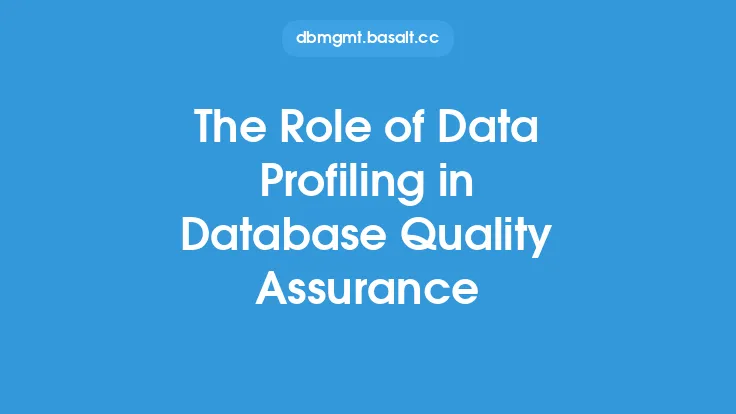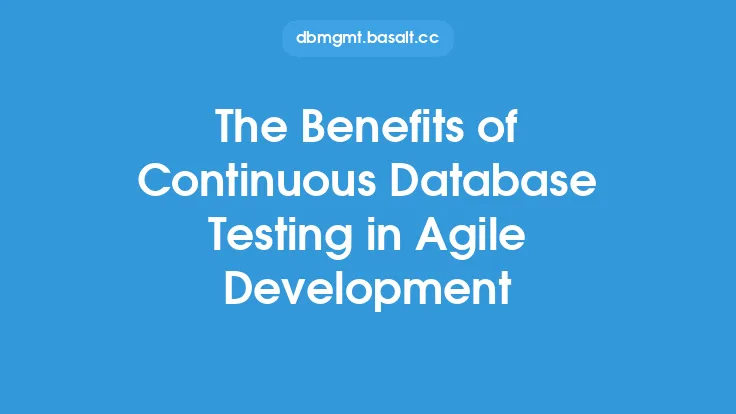In the realm of database administration, ensuring the quality and integrity of databases is paramount. One crucial aspect of achieving this goal is through the implementation of Continuous Integration and Continuous Deployment (CI/CD) pipelines. CI/CD is a methodology that has been widely adopted in software development to improve the speed and reliability of application deployments. However, its application in database quality assurance is equally vital, as it helps in maintaining the health, performance, and security of databases. This article delves into the concept of CI/CD in the context of database quality assurance, exploring its benefits, challenges, and best practices for implementation.
Introduction to CI/CD in Database Quality Assurance
CI/CD in database quality assurance involves the automation of database testing, validation, and deployment processes. Continuous Integration refers to the practice of regularly integrating code changes into a central repository, where automated tests and builds are executed to ensure the integrity of the database schema and code. Continuous Deployment takes this a step further by automatically deploying these changes to production environments after they have passed through the CI pipeline. This approach ensures that databases are always in a releasable state, reducing the risk of errors and improving the overall quality of the database.
Benefits of CI/CD in Database Quality Assurance
The implementation of CI/CD pipelines in database quality assurance offers several benefits. Firstly, it enhances the speed of deployment, allowing for faster time-to-market for new database features and fixes. Automated testing and validation reduce the likelihood of human error, improving the reliability and stability of database deployments. Additionally, CI/CD promotes collaboration among development and operations teams, fostering a culture of shared responsibility for database quality. It also provides a clear audit trail of all changes made to the database, which is crucial for compliance and security purposes.
Challenges in Implementing CI/CD for Database Quality Assurance
Despite the benefits, implementing CI/CD for database quality assurance comes with its own set of challenges. One of the primary hurdles is the complexity of database schema changes, which can have far-reaching impacts on the application and data integrity. Unlike application code, database changes can be more difficult to roll back, making it critical to get them right the first time. Moreover, databases often contain sensitive data, which must be protected during the CI/CD process. This requires careful consideration of data masking, encryption, and access controls within the pipeline. Finally, achieving the right balance between automation and manual oversight is crucial, as over-reliance on automation can lead to unforeseen consequences.
Best Practices for Implementing CI/CD in Database Quality Assurance
To overcome the challenges and maximize the benefits of CI/CD in database quality assurance, several best practices can be adopted. Firstly, it's essential to version control database changes, just like application code, using tools like Git. This allows for the tracking of changes and collaboration among team members. Automated testing should be comprehensive, covering not just the database schema but also data integrity, performance, and security. Data masking and encryption techniques should be employed to protect sensitive data during the CI/CD process. Moreover, continuous monitoring and feedback loops are critical for identifying and addressing issues promptly. Finally, adopting a incremental and iterative approach to CI/CD implementation can help in managing complexity and risk.
Tools and Technologies for CI/CD in Database Quality Assurance
A variety of tools and technologies are available to support the implementation of CI/CD in database quality assurance. Version control systems like Git are fundamental for managing database changes. Automated testing frameworks such as tSQLt for SQL Server or utPLSQL for Oracle enable the creation of unit tests for database code. Continuous Integration servers like Jenkins, Azure DevOps, or GitLab CI/CD can automate the build, test, and deployment process. Database deployment tools such as Redgate's SQL Compare or Apex Data Loader facilitate the automation of database schema changes. Additionally, monitoring tools like Nagios or Prometheus are essential for continuous monitoring of database performance and health.
Conclusion
In conclusion, Continuous Integration and Continuous Deployment play a vital role in database quality assurance, offering benefits such as improved deployment speed, reduced error rates, and enhanced collaboration. While challenges exist, adopting best practices and leveraging the right tools and technologies can mitigate these risks. As databases continue to be the backbone of modern applications, ensuring their quality, security, and performance through CI/CD is not just beneficial but necessary. By embracing CI/CD in database quality assurance, organizations can ensure the integrity, reliability, and security of their databases, ultimately contributing to the success of their applications and business operations.





